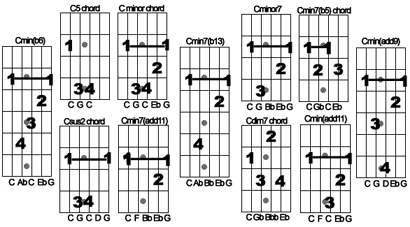As discussed in a previous column (see "Theoretically Speaking"), music theory can play an important role in one's songwriting development. In this lesson, we'll take that concept and bring it to life. This month's column pertains to how I approach chord forms to create interesting melodies and modal movement. Whether you have some knowledge of music theory or not, this lesson should be a fun exercise in hopefully approaching your guitar from a different perspective.
When delving into chord melodies and modal movement, I always take a jazz approach. Regardless of the style of music, I find that knowing even the slightest bit of jazz will open doors for you in regards to melody, harmony and elaborate chord forms/ progressions (i.e. polyrhythms, tetrachords, inversions, tensions, etc.). Let's start simple and begin with the C5 chord (all chord types are shown in detail below - the chord name is listed at the top, the fingerings are mapped out and the notes being played are located at the bottom of the chart... no open strings are played).
Please note that as long as you keep these exact chord forms/ shapes the same and move around the fretboard, the chord type never changes, only the root note is changed (i.e. C5 is played on the 3rd fret, but played on the 8th fret is F5, etc.)
Most guitarists learn this shape in the very early stages of their playing. It is the chord most commonly used in Rock and never gets old. From Black Sabbath ("Iron Man") to Metallica ("Fade To Black") to Nirvana ("Smells Like Teen Spirit"), this is the quintessential "Rock" chord. Chords are developed based upon the 3rd note of their respective scale, which in this lesson, is the "C" major scale (C D E F G A B). It is called the C5 chord because it is neither a major nor a minor chord: just the root note and its 5th scale tone. The C5 chord is spelt out: "C" & "G". Without the 3rd note (in this instance: "E"), the musician can solo using either a C major or minor scale (or both) when soloing or playing melodies with relative ease and not have to worry hitting any 'odd' notes.
By adding that 3rd note to the C5, we now give the listener a sense of how the mood of the song is going to go. Adding the 3rd note of the scale to this chord will make the chord major whereas flatting the 3rd (playing the note a half step lower) gives it the minor nametag. Many people equate a "major" sound as being upbeat whereas a "minor" sound is more melancholy. For this lesson, we'll deal with minor chords, specifically the C minor chord. This chord is spelt out: "C" "Eb" & "G".
Moving along, if we take that same chord form and remove the 4th (or "pinky") finger, thereby adding an extra note, we have just created a Cminor7 chord which consists of a "C" "Eb" "G" & "Bb". Now we're starting to get more technical and beginning to think from a Jazz perspective.
From there, the sky's the limit. Below is an outline of various other chord forms that can be built around the C5. Feel free to experiment and morph them into shapes and sounds that you are comfortable with and enjoy playing. Try these chords on different strings (for instance, move C minor chord form down to the low "E" string while staying on the same fret and you'll have a G major chord) to mix things up a bit. Try using the C major chord ("C" "E" & "G") as well. Hopefully this lesson will open doors for you musically and help you come up with some new ideas for songwriting.

Patrick DeCoste is a Boston area guitarist whose original music on his debut CD features well-rounded exploration, tasty lines and burnished production, giving one's imagination license to wander..
His latest CD is entitled "Inside The Unsaid".